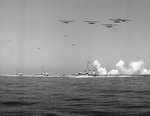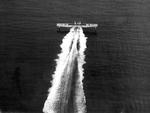PBY Catalina
| Country | United States |
| Manufacturer | Consolidated Aircraft |
| Primary Role | Seaplane |
| Maiden Flight | 28 March 1935 |
Contributor: C. Peter Chen
ww2dbaseTo call PBY Catalina a multi-role aircraft was proper, but it was also emotionally a understatement, for Catalinas really did just about everything during WW2 with every branch of the American military and some even served with the rest of the Allies. Though originally designed as a patrol bomber, they were used as anti-submarine warfare aircraft, patrol bombers, convoy escorts, search and rescue aircraft, and transports. Being flying boats rather than the typical aircraft, they required no airfields, which made them especially versatile in the South Pacific.
ww2dbaseCatalinas and variants also served under Russian, British, New Zealand, and Australian flags.
ww2dbase"Like Uncle Wiggly of nursery fame, the Cats were always searching for adventure and frequently found it", said Samuel Eliot Morison in his book on the Guadalcanal Campaign. To the American men who served in that campaign, the sight of Catalinas were a welcomed one, especially for downed airmen who spotted "Dumbo" flying toward them on the horizon with a doctor and a pharmacist's mate onboard. When it came time to bombard Japanese bases, these aircraft were not shy either; on 13 Dec 1942, "Black Cats" from Henderson Field were sent as a group to bombard Munda Field in New Georgia.
ww2dbaseAfter the war, Catalinas remained in service until the 1980s. Even today, a few of these flying boats remained in civilian service as transports or firefighting aircraft in ports.
ww2dbaseSources: the Struggle for Guadalcanal, Wikipedia.
Last Major Revision: Mar 2006
PBY Catalina Timeline
| 1 Nov 1941 | American PBY Catalina aircraft provided air cover for Atlantic convoy ON 30. |
| 3 Nov 1941 | American PBY Catalina aircraft provided air cover for Atlantic convoy ON 31. |
| 13 Nov 1942 | US Navy pilot Lieutenant H. S. Blake flying a PBY-5A Catalina with Patrol Bombing Squadron VPB-92 detected Vichy French submarine Le Conquerant 700 miles off Casablanca, French Morocco, which refused to answer recognition signals when challenged. Blake attacked, blowing off the conning tower, and sank the submarine with all aboard lost. |
| 14 May 1943 | The United States Navy achieved its first success with the Mark 24 FIDO acoustic homing torpedo when Lt(jg) Phillip Bodinet of Patrol Squadron VP-84 flying a PBY-5A Catalina dropped one Mark 24 torpedo against German submarine U-640 about midway between Iceland and Greenland resulting in the loss of the boat and all 49 on board. |
| 26 May 1943 | The United States Navy’s Patrol Squadron VP-84 scored another success with the Mark 24 FIDO acoustic homing torpedo south of Iceland when Lt Robert Millard dropped one Mark 24 torpedo from his PBY-5A Catalina against German submarine U-467. The U-Boat was lost with all 46 hands. |
| 24 Jun 1943 | PBY Catalina aircraft flying with Patrol Squadron VP-84 located German submarine U-194 in the mid-Atlantic and launched one Mark 24 FIDO acoustic homing torpedo. U-194 was lost with all 54 hands. |
| 4 Aug 1943 | A radar-equipped PBY Catalina conducted a pre-dawn bombing raid of the Japanese submarine base and main camp area on Kiska Island. The single Catalina also dropped 92 empty beer bottles (for the disconcerting whistling effect they produced) on those targets. |
SPECIFICATIONS
PBY-5A
| Machinery | Two Pratt & Whitney R-1830-92 Twin Wasp radial engines rated at 1,200 hp each |
| Armament | 2x7.62mm nose turret machine guns, 1x7.62mm tail machine gun, 2x12.7mm waist blister machine guns, optional 1,814kg of bombs, depth charges, or torpedoes |
| Crew | 8 |
| Span | 31.70 m |
| Length | 19.46 m |
| Height | 6.15 m |
| Wing Area | 130.00 m² |
| Weight, Empty | 9,485 kg |
| Weight, Maximum | 16,066 kg |
| Speed, Maximum | 314 km/h |
| Speed, Cruising | 201 km/h |
| Rate of Climb | 5.10 m/s |
| Service Ceiling | 4,000 m |
| Range, Maximum | 4,030 km |
Photographs
 |  |  |  |
Please consider supporting us on Patreon. Even $1 per month will go a long way! Thank you. Please help us spread the word: Stay updated with WW2DB: |
Visitor Submitted Comments
15 Jun 2012 08:54:21 AM
need help on aviation painting of vp-23 pby
need to know of markings on port side of aircraft.
ex did it have 23-p-5
its for the battel of midway
13 Apr 2013 04:13:19 AM
looking for names of crew on catalina that spotted bismarck 26th.may 1941
17 Aug 2014 03:32:21 AM
My granduncle John Nolan was the flight engineer on the Catalina that spotted the Bismarck and was from Tralee Co. Kerry.
31 Mar 2015 11:38:41 AM
My grandfather was an flight engineer on the Catalina that spotted the Bismarck, Mr Les Burton, saldy passed away Monday 30 March 2015.. is there anyway of either getting intouch with the society or just getting a list of all crew members..
12 May 2015 11:03:47 AM
I am looking for the tail no. of the PBY flown by Robert French on Aug. 2, 1945 that 1st spotted survivors from the USS Indianapolis that was torpedoed by Japanese Sub I58
12 May 2015 06:37:36 PM
To Mr. Griffin, Comment#6:
It is not clear what you are asking about. The first to spot the Indianapolis survivors in the water was LT-jg Wilbur Gwinn on 2 Aug 1945 flying a PV-1 Ventura with VPB-152 out of Peleliu (unknown aircraft BuNo). The first PBY Catalina to land among the survivors was piloted by Lt Adrian Marks of VPB-23 also out of Peleliu (PBY-5A BuNo 46472). This plane landed on the water but did not take off again, instead it was scuttled the following day. The first surface vessel to arrive (night of 2 Aug 1945) was USS Cecil J. Doyle (DD-368) commanded by LCdr W. Graham Clayton (later Secretary of the Navy and Deputy Secretary of Defense). I do not see a Robert French anywhere in the Indianapolis story.
14 May 2015 08:20:23 AM
Flight Sergeant Victor Taylor:
My Uncle was Victor Charles Taylor from the UK, who had a varied flying career from learning to fly at Pensacola.
He flew Catalinas in the Pacific war and I would dearly love to be able to trace any records or information relating to this.
His final flight was in a B17 which crashed into the sea in the Bay of Biscay after engine failure, but he was one of three survivors. This was during a meteorlogical survey in January 1946.
Thanking you greatly in anticipation.
Richard W. Taylor
11 Nov 2016 11:30:07 AM
I have a picture of my grandfather standing next to what I was lead to believe is a PBY2-P-3. Hew was a Naval aviator until his death in the Atlantic in May 1941. I was wondering the hisoty of the plane he is standing next to.
10 Feb 2017 09:30:07 PM
I have a good friend, his name is Angel Sandoval, He served in the Navy during WWII. He was attached to a PBY Squadrons (I think he told me PB217) and spent from 1943-1944 on an airbase on an island in the Pacific. My friend is now 96 years old. jst trying to find information n history of his squadron. Where can I go for help
10 Feb 2017 10:55:10 PM
R. Molina (above):
To learn more about Mr. Sandoval’s squadron history, you first need the precise designation for his squadron. Navy fixed-wing aviation squadron designations all start with the letter V and PBYs mostly flew with Patrol Squadrons (VP), Patrol Bombing Squadrons (VPB), and a few Bombing Squadrons (VB). I only made a quick search but I could find nothing for VP-217, VPB-217, or VB-217. The number 217 is a little high for the range of most of these squadron numbers. The highest I found was VPB-216 which flew out of Saipan in 1944 but they flew PBM Mariners instead of PBY Catalinas. Find out the precise squadron designation and Google it, you should get some results.
10 Jul 2017 04:08:23 PM
My dad Frank Eisele was a pilot for the PBY squadron VPB20, I would love to get more info on this. I have his flight log and have some idea of his flights/missions.
Thx
B
9 Dec 2017 10:09:12 AM
My dad flew in the South Pacific with VPB 52, he is 95, and very healthy. He would love some contact with other PBYers!! He is in the process of writing his memoirs!!
20 Jul 2018 03:35:30 PM
Can anyone tell me what PBY squadrons were stationed in the Solomons in August 1943?
24 Sep 2018 03:36:54 PM
I have a relative George W. Altman who was a member of a PBY flight crew. I am looking for more information as well.
2 Nov 2019 12:59:19 PM
My Dad was a WAG in the RCAF in Iceland
19 Feb 2020 07:54:37 PM
Hi there, Not sure if this helps. I know my Grandfather, Robert Dilworth was a Lieutenant of VP-52 Black Cats. He was in Solomons but I'm not sure when.
12 Jun 2021 03:23:20 PM
My late father flew in PBY’s in the Pacific. He once told me as a child that his plane helped to rescue men from the INDIANAPOLIS. That didn’t mean much to me as a child, but I would love to know if he was a member of the crew. His name was Paul Nazarok and was a radioman/navigator
12 Sep 2023 11:42:09 PM
My grandfather was division leader of VP-14 at pearl harbor during the attack.
All visitor submitted comments are opinions of those making the submissions and do not reflect views of WW2DB.
» Guadalcanal Campaign
- » 1,167 biographies
- » 337 events
- » 44,606 timeline entries
- » 1,243 ships
- » 350 aircraft models
- » 207 vehicle models
- » 376 weapon models
- » 123 historical documents
- » 261 facilities
- » 470 book reviews
- » 28,501 photos
- » 365 maps
Fleet Admiral Chester W. Nimitz, 16 Mar 1945
Please consider supporting us on Patreon. Even $1 a month will go a long way. Thank you!
Or, please support us by purchasing some WW2DB merchandise at TeeSpring, Thank you!
1 Sep 2007 11:16:41 AM
On a patrol on Mat 26,1941 a Catalina of No.209 Squadron RAF based at Castle Archdale in Northern Ireland spotted the German battleship Bismarck which had become lost to the searching Royal Navy vessels. Its location report would lead to the eventual destruction of this mighty German warship.